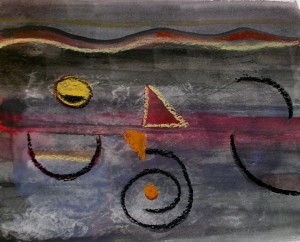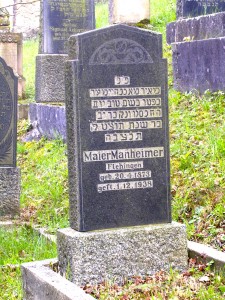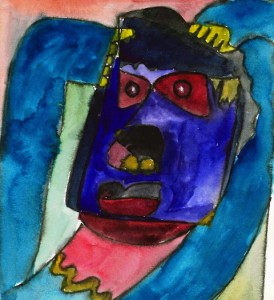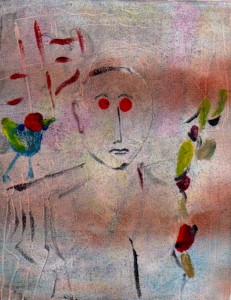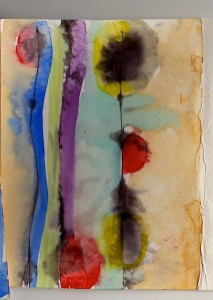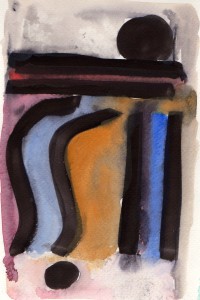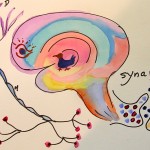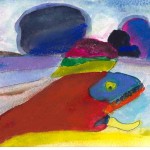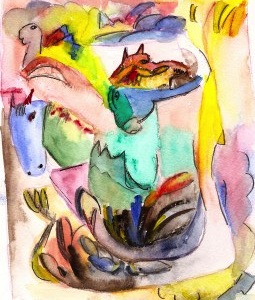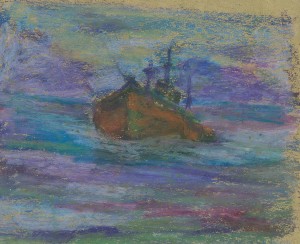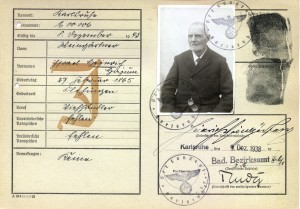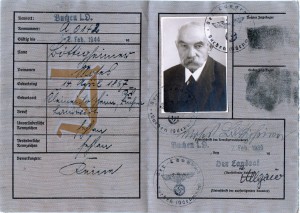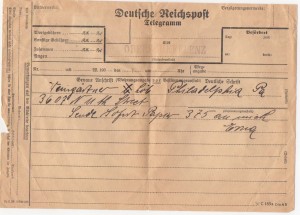Project: Flehingen; The post Holocaust descendants of a small village in SW Germany
Flehingen Project: The post Holocaust descendants of a small village in SW Germany
Synopsis: This project is designed to compliment the efforts of those individuals who are attempting to build a ‘living museum’ to document the presence of a small Jewish community that lived in the village of Flehingen prior to WWII. This website posting provides a log of the activities and findings of those working on the Der Museumsverein Flehingen-Sickingen [(MVF). In addition the project on this website explores some of what is known from mind/brain science and applies that knowledge to further understand the impact of the Holocaust-related experience of those Jews who lived in Flehingen, those who escaped and those who did not survive, and the legacy left to their descendants.
In the spring of 2011 I received an email from Wolfgang Schönfeld who lives in Zaberfeld in SW Germany. Zaberfeld is a small village about 10 kilometers from another village, Flehingen, where I was born. The villages straddle the divide between the provinces of Baden and Württemberg not far from Karlsruhe Germany and Strasbourg France. Flehingen is rural, old (established about the year 600) and has a bit of a charm to it (in part because of a castle, now a school that sits in the center of the village.
Wolfgang asked me for some details that complimented what he already knew about my family’s escape from Nazi Germany in 1939. Wolfgang serves as the biographer for a project called Der Museumsverein Flehingen-Sickingen [(MVF) The Flehingen-Sickenheim Museum Society)], which was established in 2009 to commemorate and document the presence and demise of the Jewish community who once lived in the village of Flehingen. The scope of the MVF would includes gathering materials that provide a sketch of Jewish communal life before the Nazis came to power, the impact of Nazi rule on that community and what happened to all of the members of that community prior and during World War II and its aftermath. The goal of the MVF is to establish a free standing museum that would house and display materials, such as pictures of people and places, identity cards, documents from Yad Shem as from local and national French government offices, artifacts, details of escape routes from Germany into France, villages in which Flehingen Jews hid during German occupation in France.
Of course it is not a surprise. Becoming a collaborator of the Flehingen Museum Project has, understandably, pushed me to ask all sorts of questions about my early history, that of my family, relatives, members of my Flehingen community, their descendants, and the trajectory of the lives of those who were able to escape Germany prior to WWII and those who, after that, survived either in hiding or in camps. What a huge canvass to be filled in with thumb nail sketches and partial answers to all sorts of questions. It is overwhelming and the scope is ridiculously unrealistic. So what.
Bringing my questions closer to earth by asking myself and, most recently, my relatives, including my brother, “who were these people who once lived in Flehingen, what were they made of, what made it possible for them to survive. Who were my parents, not the facts, but the stuff they were made of, and what allowed them to muster the strength and capacity to escape before it was too late. Who were they when they arrived in a new land, with 2 little kids, with little education, no English, and the life skills that were useful in a small village but in New York City? How did they manage to ‘translate’ what they knew so that they could survive and manage to keep their cool and imagine a day with less stress and more resources? How did they somehow help nurture their children in a culture that was totally unfamiliar and challenging? Who were they, their relatives, their neighbors from “the old country?”
I marvel at how dense, perhaps more accurately, insensitive I was then, as a youngster, and later as an adult focusing on all of their blemishes and shortfalls. Why couldn’t they be like all the other with it American parents. They would have been just like them if they were like them but they were different and could do things that in retrospect were amazing (because they had to in order to survive).
So now, here I am, an old man, yes I can hardly believe it I am as old as my father’s parents who escaped al most when it was too late and then came to live with us in the ‘Big Apple’. Incredible. Maybe I can begin to understand who all these people were as they struggled to escape Nazi terror and while they tried to rescue those left behind and how they managed to survive and prosper in the new world. It would seem that understanding is a prerequisite for real respect for all those refugees.
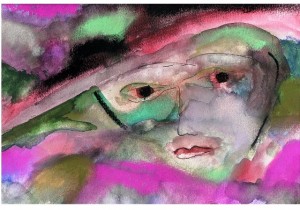 The project is not designed to be a static archival record of past events but rather as an instrument for teaching young Germans about their own history in the hopes of learning more about the nature of racism, the breakdown of civilized life, law and community, and the relationships between victims and perpetrators of hate and murder. Obviously this is a very ambitious goal.
The project is not designed to be a static archival record of past events but rather as an instrument for teaching young Germans about their own history in the hopes of learning more about the nature of racism, the breakdown of civilized life, law and community, and the relationships between victims and perpetrators of hate and murder. Obviously this is a very ambitious goal.
The MVF does not, as yet have a ‘home’ but does have a website and an ongoing newsletter both of which can be found at http://www.museumsverein-flehingen-sickingen.de/berichte-aktivitäten/
What could a project like this add to what has already been learned from the huge literature documenting all sorts of facets of the Holocaust both in and outside Germany? Perhaps some of the added value of the MVF to Holocaust ‘literature’ is the very small scale/focus of the project, (one small rural community of about 1500 inhabitants and including about 150 Jews whose families had lived in the village for hundreds of years prior to the Hitler era). It is therefore not too surprising that Wolfgang Schönfeld and his colleagues has been able to account for what happened to every Jew who remained in the village in the 1930’s and those that were still there as of 1939.
As soon as Wolfgang Schönfeld contacted me I knew that I had to become actively involved in this project. Wolfgang and I became close friends and not merely collaborators working at a distance from one another. What also helped bond us together was not just the spirit of the project but that I could still speak to him in the distinctive Badisch accent of that region of Germany. I sent him copies of pictures, contacts to family members, copies of books and artifacts that were rescued from the Synagogue on Nov 10 1938 by my grandfather. I also sent him a picture of me (age 4) and my brother Werner in the arms of my grandfather Heinrich standing in the snow in front of the burned out synagogue in ‘downtown’ Flehingen circa 1939 (reprinted below). Of course I had to become involved in the MVF project? What could I do (aside from sharing documents, artifacts, history) to contribute to this project? How might I fulfill a useful role as a MVF collaborator?
In April of this year I came to Flehingen and met in person Wolfgang Schönfeld. As soon as we met we gave each other a big hug and then I met his wife Petra and in the days that followed his daughters and grandchildren. We were together as a family. I also met and spent time with some of his colleagues.
Ariel view of the village of Flehingen
We walked through Flehingen visiting my old house, touring the village from the perspective of the history of my families and the others of our community who lived around us, visiting the Jewish cemetery at the edge of town. It was as expected a powerful experience as well my wife Laurie who thought the village was charming and inviting.
Picture of Wolfgang and me in front of my former home in ‘downtown’ Flehingen
In the following days I was briefed on all of the difficulties and roadblocks that have plagued the MVF. It is not surprising that historical reminders are not everyone’s ‘cup of tea’. Several days later as I left the village, Wolfgang Schönfeld and his family, we planned our next meeting together along with what I might do to further the progress of the MVF. A few days later I talked to Wolfgang and he said that he was saddened to not hearing a knock on the door, answering it, and seeing Laurie and I standing there. We planned to meet again in the fall of 2012 either in Flehingen or here is the US. It turns out that Wolfgang will becoming to stay with Laurie and I in New York City and Washington DC) in mid November. We have a good deal of work to do together and separately. Wolfgang will be gathering more biographical material from several individuals with ties to Flehingen and will also work with archival materials available in New York such as the Leo Baeck Institute and at the Holocaust Museum in Washington DC.What can I do that could be of value to the MVF? In the past months I have tried to think through and discuss ways of getting the Province of Baden- Württemberg to become more active in support of the MVF and likewise to get more support from the mayor of Flehingen and the neighboring village of Oberderdingen. I have also contacted German Television to try and get them interested in airing the MVF story. In addition I believe that an interim solution may be useful. An effective exhibition tool to display the materials gathered by the MVF may capitalize on a traveling exhibit called Lawyers Without Rights – Jewish Lawyers in Germany Under the Third Reich that is currently circulated throughout the USA and sponsored jointly by the German Federal Bar and the American Bar Association. We will see whether this idea has ‘legs’.
More directly I am developing the The Flehingen collaborative project on the Mindinplay.com website both to help support and publicize the MVF and to compliment MVF efforts. What I have in mind is to try and enlist contributions from mind/brain scientists who might comment on some of the important themes that can help us understand more about the rise of Nazism in Germany, the subsequent destruction of civilized life in Germany and how these events spiraled into the Holocaust. Obviously tons of materials have been written about every facet of the Holocaust and the Nazi era in Germany. That literature includes contributions by historians, novelists, filmmakers, photographers, biographers and autobiographers, political scientists, ethicists, anthropologists, politicians and more. The knowledge and theories from mind/brain science has been less in evidence in our portrait of the Holocaust and for good reason. Most neuroscientists shy away from problems (questions) that are overwhelmingly complex and instead. Understanding how neurons communicate is a safer and more fertile field of enquiry than the determinants that can account for themes such as race hatred and the murder of children. Can mind/brain science be of value in understanding what happened in Flehingen and beyond? Perhaps but it is as we say a long shot.
Outline of the Flehingen collaborative project (MVF)
 Here is an outline of what you will find below. It will involve in time but at the moment there are lots of gaps and only in time will I be able to fill them especially those based on the contributions of others. I often think of this project as being both intellectually and emotionally overwhelming.
Here is an outline of what you will find below. It will involve in time but at the moment there are lots of gaps and only in time will I be able to fill them especially those based on the contributions of others. I often think of this project as being both intellectually and emotionally overwhelming.
I find it helpful to sometimes use art to help express myself so the posting is sprinkled with some of my sketches and photos that perhaps may enhance text material.
- Remains of the Jewish presence in Flehingen
- The principle collaborators of the MVF project
- Some mind/brain science themes that may be useful in helping to account for the events associated the development and support of Nazi policy, how it may have impacted the lives of all Germans and made the Holocaust a reality. This facet of the collaborative project will be highly dependent upon input from mind/brain scientists that will be asked to contribute their thoughts to this website.
- Details about the Jewish community in Flehingen and what happened to each of the families that lived in the village (in pictures and words).
What remains of a Jewish community presence in Flehingen today?
- There is an old synagogue which is barely still standing and whose inner sanctuary is in total disrepair. One that was built at the beginning of the 20th century replaced this synagogue. The latter synagogue was burned down on Kristalnacht Nov. 9-10 1938. Below you will find a picture of my brother and I standing with our grandfather in front of the destroyed synagogue (dated January 1939). Wolfgang Schoenfeld the biographer of the Flehingen Museum Project has reconstructed what the synagogue looked like using notes and the picture of the destroyed synagogue.
- A Jewish cemetery is reasonably well maintained and sits on a small hillside off the main road leading out of Flehingen. That is the final resting place for my relatives and co-congregants of the Flehingen Jewish community dating back several hundred years.
One of the gravestones ( a relative) in the Jewish Cemetery in Flehingen
3. There are several houses, which were once the homes of Jews in the village that are sprinkled about the town center. My home stands in the middle of Flehingen and still has the markings where the mezuzah was attached in the entrance way next to the front door of the house.
4. There are also some shops and a restaurant on a hill= just outside the village that were owned by Jews that remain in use by those villagers and their kin who bought them at the time at ‘fire sale’ prices.
5. One curious custom also remains that can be traced to the Jewish community of Flehingen. On Friday morning the Jewish women of the community would either bake or buy ‘Berches’ (the German Jewish name for the bread used as part of the Friday evening meal in celebration of the upcoming Sabbath, which was observed, by all of the Jews in Flehingen. Berches is what the Jews of that region of Germany called Challah; braided bread made with slightly sweetened dough and is traditionally used as part of the Friday evening meal in many Ashkenazi Jewish homes (i.e., most eastern European Jews, and Jews in much of the western world. On my visit to Flehingen which was designed around my plans to become more actively involved in the FMP I was more than a little surprised when I found out that the Bäckerei still sells Berches on Friday morning (and only on Friday morning) and it looks exactly like what a Berches should look like, braided and with sprinkled with poppy seeds. The owners and sales woman of the Bäckerei have no idea where the Berches tradition came from or what it represented or the symbolism behind the Berches. Evidently the villagers like the taste of that bread kind of bread.
By the way the family that owned and ran the Flehingen Bäckerei were the Ackermann’s (one of the Jewish families in the village). When they were escaped Germany they left behind the tradition of baking and Berches and selling them on Friday mornings. Unfortunately the Berches sold today looks like a Berches (like Challah it is braded and topped off with poppy seeds) but does not taste like it should. They left out of the recipe the eggs and the touch of sweetener. Oh well.
MFV Museumsprojekt
Museumsprojekt (Museum project)
Ansprechpartner (contact): Ute Coulmann
Ortsarchiv (local Archives)
Ansprechpartner: Ellen Rausch
Biedermeier-Kostümgruppe (Biedermeier costume group)
Ansprechpartner: Brigitte Springer
Jüdische Geschichte (Jewish history)
Ansprechpartner: Volker Geisel
Buchreihe ( Book Series)
Ansprechpartner: Volker Reeck M.A.
Spolien-Projekt (Robberies project)
Ansprechpartner: Gerhard Obhof
Historische landwirtschaftliche Geräte & Techniken (Historic farm
Equipment & Techniques)
Ansprechpartner: Sabine Zimmermann
Archäologie (archeology)
Ansprechpartner: Vorstand, Sven Jäger M.A.
Benefiz-Konzerte (Benefit concerts)
Ansprechpartner: Günter Zeller
Auswanderung (emigration)
Ansprechpartner: Sven Stromann-Bräuer M.A.
Biographien ehemaliger jüdischer Bürger (Biographies of former Jewish citizens)
Ansprechpartner: Wolfgang Schönfeld
Öffentlichkeitsarbeit & Kooperationen (Public Relations & Co-operation)
Ansprechpartner: Ute Coulmann
Flehingen Museum Log
The file ‘Flehingen Log and contacts’ contains: a) lists a condensed account of activities and review of discussions (10 November to 20 December 2012); b) uncompleted tasks; c) proposals for possible future development; d) a partial list of contacted individuals (and most of them are on the current distribution list of this e-mail.
Activities
Wolfgang arrived in New York on 10 December and stayed with my family in both NYC and Washington DC (until 30 November 2012). During the visit we spoke and met with descendants of Flehingen as well as individuals representing a variety of Holocaust-related institutions (contacts are listed in the table below). I may have mislabeled the titles of the individuals listed ….so please correct any errors.
- Review of archival work (Wolfgang Schoenfeld)
- Wolfgang Schoenfeld has unearthed a huge amount of data on what happened to each of the Jews that remained in Flehingen in 1939 as well as those that successfully immigrated a few years earlier. For example:
i. Deportation lists of everyone who remained in Flehingen in 1939.
ii. The names of those responsible for burning down the Flehingen synagogue (they were all from Pforzheim).
iii. The travel routes through France of Flehingen Jews including those who successfully escaped and those who did not.
iv. The French internment camps where Flehingen Jews ended up and the camps, transfers to other camps, details of deportations to extermination camps.
v. Villages in France where Flehingen Jews were hidden and the circumstances that allowed for survival.
vi. What happened to Flehingen Jews who successfully immigrated from western Europe
vii. And a great deal more information…..for details contact Wolfgang Schoenfeld.
- Review of archival research (to be continued) with each of the institutions listed below. In addition findings were reviewed from the extensive archives in Karlsruhe and Stuttgart Germany. This research is also in process (Wolfgang Schoenfeld).
- Meetings held, interviews with contacts
- Sarah Hyams (USHM)
- Frank Mecklenburg (Leo Baeck Institute)
- Esther Brumberg (Museum of Jewish Heritage, NYC)
- Norbert Heidelberger (phone contact, previously from Flehingen)
- Edith Hausmann (cousin, hidden in Annecy France throughout WWII)
- Howard Stahl (grandson of Rosa Stahl who was hidden in France shared a huge amount of material with us and donated materials to the Museum of Jewish Heritage, NYC
- Ilse Weingartner (cousin) survivor, Kinder transport in 1939)
Additions March 14, 2013
My note to Karen Franlin, Holocaust researcher, and the only US member of the committee for selecting each year’s reciepient of the OBERMAYER GERMAN JEWISH HISTORY AWARD. The purpose of my note is to lay out some of the logic of trying to use mind/brain science as a vehicle for understanding the complexities of the refugee adjustments to the new world (after escaping Nazi Germany). Some of the themes that may be of particular interest are listed below.
My e mail note to Karen Franklin was:
“I know I repeat myself but this entire project, starting with Wolfgang contacting me 2 years ago has been one powerful experience. It has made me look at my own development, but more importantly, the extraordinary bravery, commitment, resilience of so many in my family (and by extrapolation, the 10s of thousands of people who survived and continued life’s journey. What made them tick? How did they manage? I guess the bold outlines of their adjustment has been well covered but I am interested in what was going on under their skin, in their heads, those that managed successfully and those that didn’t do as well.
Poking around in the heads of folks has been what I have done as a researcher but I have picked my problems and avoided those that were too difficult to research…..like the one I am just beginning to explore in the lives of refugees.”
And her response to me was “We all have those questions, especially those of us who work in the field. And I often think about the difference in the survivors who were older and lived only to the 1950′s and 1960′s, and those who remain.”
About the award for which I am nominating Wolfgang Schoenfeld.
The Obermayer German Jewish History Awards are given annually to individuals who have made outstanding voluntary contributions toward preserving and recording the Jewish history, heritage, culture and/or remnants of local German communities. The awards, which were started in the year 2000, are presented at the Abgeordnetenhaus von Berlin, the home of the Berlin Parliament. They are given to commemorate the liberation of Auschwitz on January 27, 1945, which date is both the German Holocaust Memorial Day and the International Holocaust Remembrance Day. The awards are sponsored by the German Jewish Community History Council of the Obermayer Foundation, the President of the Berlin Parliament, and the German Jewish Special Interest Group of JewishGen, the leading Jewish genealogy organization on the internet.
| Contact name | Contact information(Phone numbers have been omitted) | Relationship to project |
| Wolfgang Schoenfeld | w-schoenfeld@t-online.deZaberfeld Germany | Archivist of the Project |
| Sarah Hyams | shyams@ushmm.org | US Holocaust MuseumArchivist, researcher |
| Michael Berenbaum | Michael@berenbaumgroup.com | Berenbaum group and Director of the Sigi Ziering Institute |
| Karen Franklin | karenfranklin@gmail.comalsohttp://www.obermayer.us/award/awardees.htm | Obermayer German Jewish History Awards American nominatorSpecial exhibit at Jewish Heritage Museum (NYC) |
| Dr. Frank Mecklenburg | fmecklenburg@lbi.cjh.org15 West 16th Street, New York, NY 10011 | Director of Research and Chief Archivist, Leo Baeck Institute |
| John Lowens | jplowens@gmail.com | Relation- Sigmund Weingartner, provided the affidavid of support for my family. In addition he is also tracking the history of his Flehingen-related family |
| Agnes Tucker | tucker.e@zdf.de | Contact at the German Televison Network (US office is based in Washington DC) |
| Ute Coulmann | Ute_coulmann@yahoo.deFlehingen Germany | Director of Flehingen Project |
| Volker Reeck | Volker_reeck@yahoo.deFlehingen Germany | Flehingen Project |
| Norbert Heidelberger | 1720 Fleleaf CourtFt. Collins CO 80528 | Former Flehingen residentLeft Flehingen as a 15 year old in 1937 |
| Ilse Weingartner | Westchester MeadowsApt D 352Valhalla NY 10595 | Widow of Henry (Heinz) Weingartner formerly of Flehingen |
| Edith Hausmann | Was hidden in Annecy France throughout WWII.Widow of Kurt Hausmann-cousin of Weingartners(Flehingen-Heidelberg) | |
| Michelle Giovanello; | migiovanello@jtsa.eduExecutive Assistant to the Chancellor; The Jewish Theological Seminary of America; 3080 Broadway; New York, New York 10027; | JTS |
| Howard Stahl | istahl@houlihanlawrence.com2 Claremont Road, Scarsdale, New York 10583 | Grandson of Rosa Stahl formerly of Flehingen who survived the war hidden in French village |
| Herbst Family | Philadelphia PaWolfgang has contact information | From Zaberfeld and related to Flehingen families |
| Michal Heitz | Eppingen, Germany; won Obermayer prize in 2011Wolfgang has contact information | |
| Louis Levine | Jewish Heritage Museum (NYC)Has not yet been contacted | |
| Werner Frank | wlfrank82@gmail.com | Archivist and historian of families related to both Bretten and Flehingen Weingartners |
| Esther Brumberg | ebrumberg@mjhnyc.org | Museum of Jewish HeritageArchivist and researcher |
List of uncompleted activities
- It was suggested that the United Synagogue for Conservative Judaism may have information about the missing Torah that was rescued from the burning synagogue in Flehingen (Nov 9-10 1938). Need to follow up on this lead.
- Contact the Washington Heights archivist of the refugee Jewish community that lived there before and following WWII (Frank Mecklenburg has the contact information).
- A host of activities taking place in and around Flehingen to gain support for the Museum Project.
- I have been working on a project on my website, Mindsinplay.com that is called The Flehingen collaborative project. The website has been around for several years with the goal of disseminating mind/brain science and its application (using the vehicle of stories and illustrations). While the site is being scrubbed and reformatted I continue to post materials. I plan to include this log including the material below.
For future consideration
Why not consider broadening the base of the Flehingen Museum Project? There exits a loose association of similar projects including the one successfully established in Eppingen. Aside from sharing information would it not worthwhile if the community projects banded together to work as one rather than as separate entities? This would mean a leveraging of influence and resources that could not be matched if each project were to be developed separately. Obviously each community project has unique features and collaborations so often are difficult to develop and maintain but…….why not give the idea serious thought.
A related issue …..Who else might become part of the Flehingen Museum Project? Many individuals might share their thoughts and suggestions but that is the same as joining the project. Any thoughts about recruitment wish list?
Applying a mind/brain perspective in considering the impact of Holocaust related events on the Flehingen survivors and their descendants : Some area of research and knowledge that may be useful.
This is a huge long shot. Have no idea whether this will in any way complement the work of those involved in the Flehingen Museum Project. I will find out soon enough when I get rections from mind/brain science colleagues. In the meantime I am cognizant of the mission of the US Holocaust Museum which is to not only preserve the experiences of survivors and victims of the Holoaust but also to disseminate and teach (and learn) about what happened during Holocaust.
Listed below are areas of mind/brain science research that perhaps may be useful in examining the impact of Holocaust-related events on the Flehingen Jewish community and their descendants. I realize that application of this knowledge may be too much of a ‘stretch’ but I thought it still worth a try. To make use of the mind/brain science in the areas listed below I have to turn to the experts in these areas.
In the table below I have identified a list of mind/brain areas that may be useful. I have not as yet defined any of the details that are particularly pertinent to Holocaust related events.
In the table are the equivalent of thumb nail sketched of research areas that may be of value in exploring what happened during the Holocaust. My plan is to solicit commentary from experts in each of the areas listed below.
| Behavior of interest | Can mind brain/science be applied to complex behaviors |
| Knowledge, beliefs, mythsWhat did individuals and the community know about what was going starting in 1933 and how did their beliefs, history shape their response to what was happening? | Extensive research on brain representation of knowledge, via language, pattern. Belief systems, schemas, attitudes, as determinants of how memory is changed, how events and experiences are perceived. Mechanisms that define the tools for brainwashing and the generation of fanatical beliefs. What kinds of evidence, if any, can undermine strong beliefs even for simple phenomena such as the speed of falling objects that vary in weight? For example we know that when individuals are asked to actually articulate their beliefs then some change in their beliefs can become possible.What are the principles used in the design of tools for generating myths about nationhood and characterizations of a people. What was the basis of the design of the kinds of plays, images, word used to describe Jews, descriptors, staged public events, propaganda, opera and art been used to shape myths about a nation and its history. Does mind/brain science offer any additional insights into how racism can be used to segregate and then attack selected groups within a society and also explain the expression of group vs. individual racism? |
| Resilience | |
| Vulnerability | |
| Planning and carrying out actions in the face of fear, stress, trauma | |
| Making decisions in the context of stress and absence of certainty | |
| Social bonds, interactions, trust, ties to the community | Don’t know much about this literature. How did family dynamics, relationships with neighbor’s relatives get expressed in the context of attempts to escape Germany?Is it worthwhile exploring the relationship between victim and perpetrators of the 3rd. Reich from the vantage point of current mind/brain science knowledge (such as some of the areas cited above). What is the vocabulary that can be used for understanding that relationship (i.e. Lucy Dawidowicz entitled her book The War against the Jews)?How does isolation of the victim help make the victim all the more helpless in the context of the Nazi terror? Can we learn anything from the vantage point of understanding the mechanisms of isolation and its effects?What are the accepted practices of individual and group interactions in German society? How has that changed during the last many decades? Is it relevant to the issue of the isolation of the victim in Nazi Germany? Wolfgang Schoenfeld told me a story that keeps gurgling up from my memory, a story that bothered me when he told it to me and still nags me. Several years ago while riding his motorcycle dear his village of Zaberfeld he hit gravel, the bike came out from under him and he hit the deck and for a few moments lay on his back, stunned. A small crowd of villagers gathered around him. No one came over to him to see if he needed help. No one called the equivalent of 911. The townsfolk just stood there looking at the victim of the accident. It turns out, that by chance, his wife came by in her car and saw her husband on the ground next to his motorbike and of course ran over and was relieved that aside from a few scraps and a shredded jacket that Wolfgang was all right. What were all these witnesses thinking about as they stared down at the accident victim? Did they think that it was not their business to intrude by helping someone who was injured? Was each waiting for someone else to do something? Was what was acting out in this scene a sharp departure of what would ordinarily have happened? |
| Cognitive resources that individuals did or did not have available | Self-regulation, executive functions, willpower. Functions that allow you to anticipate future consequences and feelings. |
| Context-dependent thinking/action in response to what was happening to the community; | |
| Cognitive styles | Huge literature; cognitive styles including, rigid rule-driven thinking, concreteness that are relevant to understanding Third Reich phenomena? |
| Memories…individual and collective | Lots of research including classic work demonstrating that remembering is an active reconstructive process with loads of opportunities for distortion, schemas, beliefs.Lots of research including classic work demonstrating that remembering is an active reconstructive process with loads of opportunities for distortion. How much of what is remembered about the ‘good life in the villages of Baden-Wuttenberg is based on real evidence/experience as opposed to active revisionist remembering? |
| Development of empathy | The interplay of biology and the environment broadly defined. As a start, see:Adele Developmental Psychology, Vol 45(1), Jan 2009, 1-8.Special Section: The Interplay of Biology and the Environment Broadly Defined. |
| Posttraumatic stress disorder (PTSD) personal resources, and posttraumatic growth (PTG) in Holocaust | This is an area that has been probably over researched with modest advances in what we know about the subject.This is an area that has been probably over researched with modest advances in what we know about the subject. How did those trying to escape Nazi Germany keep extreme stress and trauma in check? What is the history of those who could handle stress successfully vs. were swallowed up and paralyzed by fear? |
| Emotion-driven vs. cool cognition | Good deal of neuroscience research including; Automatic cognition vs. cognition with control and awareness; Nature and role of inhibitory cognitive functions |
| Psychopathology research applied to individual and group behavior | Huge body of useful research |
| Complex behaviors such as bravery, hope or hopelessness, persistence, | How do we account for who can perform acts of bravery and who cannot do so and the conditions that make bravery possible even under threat of torture and deathWhat is known about the psychology of hope and hopelessness from a mind/brain science perspective |
| Neuroeconomics | How did Jews respond to the neuroeconomics of jealousy and avarice? When you feel that your economic woes were brought on by those ‘people’ it follows that you are justified in righting a wrong. Many people got rich beyond their wildest dreams on the backs of their neighbors. A third of the money used to fuel the cost or Nazi rearmament could be traced to funds obtained from Jews (by way of special taxes, appropriation of goods and property and free forced labor). Thousands of homes and businesses were purchased by the good burgers of Nazi Germany based on evaluations of roughly 10 cents on the dollar. Neighbors taking advantage of neighbors by grabbing property at below fire sale prices was justified by the belief that the Jews were vermin who acquired their wealth by cheating their German compatriots so why not screw them in return. |
| Social structure and social institutions |
What does it mean to be civilized? This is another Holocaust theme that can easily engender discomfort. When so many Germans voted Hitler into office and it is impossible to ignore what he stood for what does that imply about the kind of civilization that existed in Germany in 1933 and beyond? It is silly to get side tracked by the contributions made by individual Germans during the 18th through the 20th. century to science, music, opera, art etc. How do these contritions alter our picture of the foundations of civilized behavior in German society even prior to the rise of Hitler? When is a sophisticated culture uncivilized? Di we feel it is incomprehensible when a sophisticated intellectual (i.e., a sensitive writer or an insightful scientist, or a beloved physician) is also a brutal husband, or an uncaring parent or a mentor that rather than support his students, use them, and we can go on but of course this is a familiar picture of the way people dissociate their lives into fragments and this is also the case for societies.
|
| WillpowerSelf-control | There is a huge literature on self-regulation. Some of the work has been developed from a developmental perspective.Willpower is one of the resources that are part of resilience.Much of the material comes from the work of Roy Baumeister.The major points that come out of his research are:
Will power is a depletable cognitive resource so that when exerting will power brain glucose is depleted. The work of Roy Baumeister is a major contributor to this area of research. |
| Cool cognition in the face of highly emotional conditions; avoiding panic response | |
| Belief, faith-based cognition | |
| Imagining the future; future prospective | People can imagine their future. It may not be realistic but imagining what might be is what people can do and they do it all the time. Can the mind/brain science that is the foundation of imagining the future of value in considering the experiences of survivors and those the refugees that escaped prior to the implementation of the final solution? In a very recent article in Perspectives on Psychological Science Seligman, Railton, Baumeister, and Sripada consider how the past determines our picture of the future but not in term of reasoning backwards causation. Instead they see “prospection involves evaluative representations of possible future states. |
Biography and fiction in the service of trying to understand the impact of Nazi oppression on the lives of victims and their descendants. Themes that are considered include: resilience, belief and faith-based thought processes, cool cognition in the context of high stress, self-regulation, willpower
Here are three pieces of work that do just that. I just finished reading, a novel, a diary and a book based on interview material that highlights issues such as resilience, response to chronic terror, and the power of kinship.
The authors of all three works have each dealt with the theme of survival while being caught up, trapped, in the hands of Nazi regime. First I think reading the well-known German writer Hans Fallada gives a particularly chilling account of bravery and resistance in the face of chronic terror in Nazi Germany. It is not about Jews trying to survive but one working class couple’s struggle to resist tyranny. The book title is Every Man Dies Alone and while published as a novel based it is based on actual events of a young couple resisting the Nazis by distributing pieces of paper, leaflets, one or two at a time, that point out the horror of 1930s Germany. In the novel, and in real life, a sustained manhunt uncovers who they are at what happens to both of them. What is startling about the book is how courage, fear, and ultimate terror come alive in a series of simple acts of defiance. Incidentally Fallada was a popular writer in prewar Germany and wrote a range of extraordinary volumes including one that captures in vivid human terms the life and struggles of an alcoholic, which could well, have been Fallada’s autobiography. The second book that is a noteworthy treatment of day-to-day terror from the perspective of an elderly couple (a husband that is Jewish and his gentile wife) is a two-volume diary of Victor Klemperer (cousin of the conductor Otto Klemperer). It is a day-by-day account of their lives and struggles to survive and to avoid being sent to a concentration camp while also finding something to eat. The setting of the diary in a small German city, Stettin, and its surrounding communities and covers the period from 1933-1945 (the book is reviewed in a previous posting). What is remarkable about Klemperer’s diary are the commonplace everyday details of fear, hope, hopelessness, and survival. His writing is so very real that you are transported to his world and can accompany him as he gets up in the morning or tries to keep warm or find a cabbage for dinner. Could we have survived in his place? The third volume I would recommend to you is Caroline Moorhead’s book A Train in Winter. The book begins with interviews of 7 women who were part of French resistance until their betrayal in Jan. 1943. They along with 239 women resistance fighters were tortured and then sent to Auschwitz. Of the 239 women who arrived in Auschwitz 49 survived. While the horrors of Auschwitz are very familiar to all of us the descriptions of the survivors of life in provides a heightened poignancy to their experience such (i.e., descriptions of women pinching the cheeks of their friends so that they look healthy enough to work another day rather than to be selected for extermination, or the more familiar scene where women carrying their dead children in their arms and would not allow anyone to take it away. You may find the interviews even more effective in communicating the horror of Auschwitz than what is ordinarily caught in film, which is perhaps not surprising since pictures capture a different reality from voices describing the ‘private’ lives of victims. Moorhead completely rattles our composure and we (I) can’t let go and read on. Apropos themes worth exploring further on this blog the book highlights the incredible power of friendship, kinship, and the bonds that link the women to one another. None of them would have survived their hell without their heroic commitment to one another. Read the book because it also underscores the power of faith in a cause and an affinity group. Yes, these themes of what allows us to survive in a place like Auschwitz have been treated by many I for one would think it is useful to go past description and explores the mechanisms that make something like an Auschwitz survival possible.
the period from 1933-1945 (the book is reviewed in a previous posting). What is remarkable about Klemperer’s diary are the commonplace everyday details of fear, hope, hopelessness, and survival. His writing is so very real that you are transported to his world and can accompany him as he gets up in the morning or tries to keep warm or find a cabbage for dinner. Could we have survived in his place? The third volume I would recommend to you is Caroline Moorhead’s book A Train in Winter. The book begins with interviews of 7 women who were part of French resistance until their betrayal in Jan. 1943. They along with 239 women resistance fighters were tortured and then sent to Auschwitz. Of the 239 women who arrived in Auschwitz 49 survived. While the horrors of Auschwitz are very familiar to all of us the descriptions of the survivors of life in provides a heightened poignancy to their experience such (i.e., descriptions of women pinching the cheeks of their friends so that they look healthy enough to work another day rather than to be selected for extermination, or the more familiar scene where women carrying their dead children in their arms and would not allow anyone to take it away. You may find the interviews even more effective in communicating the horror of Auschwitz than what is ordinarily caught in film, which is perhaps not surprising since pictures capture a different reality from voices describing the ‘private’ lives of victims. Moorhead completely rattles our composure and we (I) can’t let go and read on. Apropos themes worth exploring further on this blog the book highlights the incredible power of friendship, kinship, and the bonds that link the women to one another. None of them would have survived their hell without their heroic commitment to one another. Read the book because it also underscores the power of faith in a cause and an affinity group. Yes, these themes of what allows us to survive in a place like Auschwitz have been treated by many I for one would think it is useful to go past description and explores the mechanisms that make something like an Auschwitz survival possible.
Expanding on the mind/brain science themes that may be useful in appreciating the impact of escaping the Holocaust on survivors and their descendants.
In the table above I have listed a huge laundry list of possible mind/brain science themes that are worth considering when trying to understand the impact of the pre-Holocaust experience on the refugees who escaped Germany and on their kids. This is just a start so lots of work and much more postings will be needed if any of this material is likely to be useful.
There is no shortage of studies of the impact of the Holocaust on the lives of survivors. One thing is clear from looking at that literature…no clear answers to the cascade of questions that people ask about the lives of survivors. I guess similar questions (and lack of answers) come from studies of survivors of other devastating life events (like children flourishing despite a crushing early life experiences. Mind/brain science is not ‘there yet’ in providing solid evidence that can explain issues like resilience, vulnerability, survival in the face of sustained terror (and extreme stress). So I guess one can walk away from problems that are too complex or try and nimble away at some ‘signals’ in the midst of a huge amount of noise.
Resilience
A huge article that is a mix of science and jargon but is of some value because of the huge number of studies that are reviewed in the article is called Surviving the Holocaust: A Meta-Analysis of the Long-Term Sequelae of a Genocide by authors in Israel and Holland was published a couple of years ago (Psychological Bulletin, 2010, Vol. 136, No. 5, 677–698)
Authors were: University of Haifa and the Max Stern Academic College of Emek Yezreel; Abraham Sagi-Schwartz University of Haifa; Marinus H. Van IJzendoorn Leiden University; Marian J. Bakermans-Kranenburg Leiden University
They applied a meta analysis of data from 71 studies with 12,746 subjects). That may seem like many subject but when you consider the importance of all sorts of individual difference like, gender, age of survivor, culture they came from, pre Holocaust conditions and experiences and I can go on and on…..the point is that large samples of subjects get small when we try to control for so many individual differences.
I am not going to try and summarize the entire long article but here are some take away messages. Some are obvious findings, others are confusing and yet others are surprising. I am not going to list all of the references in the paper since you can get them from the paper directly.
- In many areas of functioning they showed amazing resilience (i.e., physical health, stress-related physical measures, and cognitive functioning)
- Holocaust survivors appear to combine resilience with the use of defensive mechanisms
- “In most domains of functioning no differences were found between Israeli samples and samples from other countries. The exception was psychological well-being: For this domain it was found that living in Israel rather than elsewhere can serve as a protective factor”
- Maladaptive Consequences in the older literature were labeled survivor syndrome and included combination of a chronic sense of anxiety, depression, feelings of guilt and more…but this is old stuff and not very useful given what we have learned about the psychobiology of stress etc.
- Recent investigations have found that survivors have hope for a better future and have higher self-esteem and sense of coherence than controls….is this a surprise?
- Despite the resilience of survivors most of the studies seemed to suggest that they did not adjust to their new world as well as controls and they also show poorer physical health than did comparisons.
- Holocaust survivors showed more symptoms of posttraumatic stress than did comparisons and were also less cognitively intact (which can be directly related to stress actors).
- The authors found traumatizing long- term consequences of the Holocaust on survivors but nevertheless, in their daily lives, were as adaptive as controls.
- Not sure one can conclude anything about who is resilient, who is not, who adapts who never gets up off the ground given the huge array of variables that we know can matter such as culture; gender; age of the children or young adults when their lives were disrupted; social factors (bonding); faith or lack of it; personality factors; intelligence; nature of primary family and of course the list can go on and on….each of these variables would logically have a modulating factor on resilience post Holocaust experience.
- Enough already but I end with the conclusion of the authors of the study which was “Our investigation suggests that Holocaust survivors demonstrate remarkable resilience in adapting to their personal, social, and communal life. “ ….and that is what I have no sense of how this works….neither does my friend and former ‘boss’ Alan Leshner (CEO of the AAAS) whose wife Agnes takes on waifs who have suffered awful events in their lives. …survived and flourished. I don’t understand and don’t even know how to begin.
Yet many more details on resilience and vulnerability
There are several key articles in the volume of articles (see list of titles below) that cover topics that may shed some light on issues such as resilience (adapting well in the face of adversity) and vulnerability of Holocaust survivors (and others following extended trauma exposure). During the next several weeks I will review some of this material and post it on this website.
Of particular note is the article by Rachel Yehuda (see below pg. 379-396) but there are other papers that should not be ignored.
It is rather clear that we know quite a good deal about the neural basis of resilience and vulnerability including:
- Key brain regions that are involved
- Neuroendocrine markers
- Behavioral factors such as optimism, cognitive flexibility, coping, social support, expertise
- A large number of the topics discussed in this volume will be of interest to you,
© The New York Academy of Sciences July 2006
Volume 1071 Psychobiology of Posttraumatic Stress Disorder: A Decade of Progress
. Preface (pages xv–xxi) Rachel Yehuda Article first published online: 26 JUL 2006 | DOI: 10.1196/annals.1364.061
Foreword
. Foreword (pages xxiii–xxiv) Farris Tuma Article first published online: 26 JUL 2006 | DOI: 10.1196/annals.1364.062
AbstractFull Article (HTML)PDF(56K)Request Permissions
. . Part I. Learning about Etiology, Pathophysiology and Treatment of PTSD from Prospective, Longitudinal, Biological Studies
. Predictors of Posttraumatic Stress in Police and Other First Responders (pages 1–18)CHARLES R. MARMAR, SHANNON E. McCASLIN, THOMAS J. METZLER, SUZANNE BEST, DANIEL S. WEISS, JEFFERY FAGAN, AKIVA LIBERMAN, NNAMDI POLE, CHRISTIAN OTTE, RACHEL YEHUDA, DAVID MOHR and THOMAS NEYLAN Article first published online: 26 JUL 2006 | DOI: 10.1196/annals.1364.001
Longitudinal Psychophysiological Studies of Heart Rate: Mediating Effects and Implications for Treatment (pages 19–26)RICHARD A. BRYANT Article first published online: 26 JUL 2006 | DOI: 10.1196/annals.1364.002
Predicting PTSD Prospectively Based on Prior Trauma History and Immediate Biological Responses (pages 27–40)DOUGLAS L. DELAHANTY and NICOLE R. NUGENT Article first published online: 26 JUL 2006 | DOI: 10.1196/annals.1364.003
Separation Anxiety as a Mediator Between Acute Morphine Administration and PTSD Symptoms in Injured Children (pages 41–45)GLENN SAXE, MEAGHAN GEARY, KATHERINE BEDARD, MICHELLE BOSQUET, ALISA MILLER, KARESTAN KOENEN, FREDERICK STODDARD and STEPHEN MOULTON Article first published online: 26 JUL 2006 | DOI: 10.1196/annals.1364.004
Efficacy of Hydrocortisone in Preventing Posttraumatic Stress Disorder Following Critical Illness and Major Surgery (pages 46–53)GUSTAV SCHELLING, BENNO ROOZENDAAL, TILL KRAUSENECK, MARTIN SCHMOELZ, DOMINIQUE DE QUERVAIN and JOSEF BRIEGEL Article first published online: 26 JUL 2006 | DOI: 10.1196/annals.1364.005
. Part II. New Insights into Cognitive and Brain Functioning in PTSD
Memory Performance in Older Trauma Survivors : Implications for the Longitudinal Course of PTSD (pages 54–66)JULIA A. GOLIER, PHILIP D. HARVEY, JULIANA LEGGE and RACHEL YEHUDA Article first published online: 26 JUL 2006 | DOI: 10.1196/annals.1364.006
Amygdala, Medial Prefrontal Cortex, and Hippocampal Function in PTSD (pages 67–79)LISA M. SHIN, SCOTT L. RAUCH and ROGER K. PITMAN Article first published online: 26 JUL 2006 | DOI: 10.1196/annals.1364.007
The Relationship Between Cognitive and Brain Changes in Posttraumatic Stress Disorder (pages 80–86)J. DOUGLAS BREMNER Article first published online: 26 JUL 2006 | DOI: 10.1196/annals.1364.008
Neuroimaging Studies of Emotional Responses in PTSD (pages 87–109)ISRAEL LIBERZON and BRIAN MARTIS Article first published online: 26 JUL 2006 | DOI: 10.1196/annals.1364.009
Toward a Psychobiology of Posttraumatic Self-Dysregulation : Reexperiencing, Hyperarousal, Dissociation, and Emotional Numbing (pages 110–124)PAUL A. FREWEN and RUTH A. LANIUS Article first published online: 26 JUL 2006 | DOI: 10.1196/annals.1364.010
Electrophysiological Responses to Affective Stimuli in American Indians Experiencing Trauma With and Without PTSD (pages 125–136)CINDY L. EHLERS, SAMANTHA HURST, EVELYN PHILLIPS, DAVID A. GILDER, MICHELLE DIXON, ABIGAIL GROSS, PHILIP LAU and RACHEL YEHUDA Article first published online: 26 JUL 2006 | DOI: 10.1196/annals.1364.011
Part III. Glucocorticoid Responsiveness in PTSD: A Common Pathway for Systemic, Cognitive, Behavioral and Neurobiological Effects of Trauma
Advances in Understanding Neuroendocrine Alterations in PTSD and Their Therapeutic Implications (pages 137–166)RACHEL YEHUDA Article first published online: 26 JUL 2006 | DOI: 10.1196/annals.1364.012
Immune Function in PTSD (pages 167–183)MARGARET ALTEMUS, FIRDAUS S. DHABHAR and RUIRONG YANG Article first published online: 26 JUL 2006 | DOI: 10.1196/annals.1364.013
Alterations in Stress Reactivity After Long-Term Treatment with Paroxetine in Women with Posttraumatic Stress Disorder (pages 184–202)ERIC VERMETTEN, MEENA VYTHILINGAM, CHRISTIAN SCHMAHL, CARIEN DE KLOET, STEVEN M. SOUTHWICK, DENNIS S. CHARNEY and J. DOUGLAS BREMNER Article first published online: 26 JUL 2006 | DOI: 10.1196/annals.1364.014
Neuroendocrine Regulation of Sleep Disturbances in PTSD (pages 203–215)THOMAS C. NEYLAN, CHRISTIAN OTTE, RACHEL YEHUDA and CHARLES R. MARMAR Article first published online: 26 JUL 2006 | DOI: 10.1196/annals.1364.015
Glucocorticoid-Induced Inhibition of Memory Retrieval : Implications for Posttraumatic Stress Disorder (pages 216–220)DOMINIQUE J.-F. DE QUERVAIN Article first published online: 26 JUL 2006 | DOI: 10.1196/annals.1364.016
Part IV. Hot Topics: Implications and of Biological Studies
Neurobiological Research on Sleep and Stress Hormones in Epidemiological Samples (pages 221–230)NAOMI BRESLAU Article first published online: 26 JUL 2006 | DOI: 10.1196/annals.1364.017
Social Context and the Psychobiology of Posttraumatic Stress (pages 231–241)SANDRO GALEA, RON ACIERNO, KENNETH RUGGIERO, HEIDI RESNICK, MELISSA TRACY and DEAN KILPATRICK Article first published online: 26 JUL 2006 | DOI: 10.1196/annals.1364.018
Clarifying the Origin of Biological Abnormalities in PTSD Through the Study of Identical Twins Discordant for Combat Exposure (pages 242–254)ROGER K. PITMAN, MARK W. GILBERTSON, TAMARA V. GURVITS, FLAVIA S. MAY, NATASHA B. LASKO, LINDA J. METZGER, MARTHA E. SHENTON, RACHEL YEHUDA and SCOTT P. ORR, for the Harvard/VA PTSD Twin Study Investigators Article first published online: 26 JUL 2006 | DOI: 10.1196/annals.1364.019
Developmental Epidemiology of PTSD : Self-Regulation as a Central Mechanism (pages 255–266)KARESTAN C. KOENEN Article first published online: 26 JUL 2006 | DOI: 10.1196/annals.1364.020
Applying Biological Data in the Forensic and Policy Arenas (pages 267–276)RICHARD J. McNALLY Article first published online: 26 JUL 2006 | DOI: 10.1196/annals.1364.021
Clinical Implications of Neuroscience Research in PTSD (pages 277–293)BESSEL A. VAN DER KOLK Article first published online: 26 JUL 2006 | DOI: 10.1196/annals.1364.022
AbstractFull Article (HTML)PDF(172K)ReferencesRequest Permissions
Part V. Contributions of Developmental and Basic Neuroscience to Understanding PTSD
Establishing an Agenda for Translational Research on PTSD (pages 294–312)MELINDA M. MILLER and BRUCE S. McEWEN Article first published online: 26 JUL 2006 | DOI: 10.1196/annals.1364.023
Neurobiological Consequences of Early Stress and Childhood Maltreatment: Are Results from Human and Animal Studies Comparable? (pages 313–323)MARTIN H. TEICHER, AKEMI TOMODA and SUSAN L. ANDERSEN Article first published online: 26 JUL 2006 | DOI: 10.1196/annals.1364.024
Toward an Animal Model of Posttraumatic Stress Disorder (pages 324–334)ANJA SIEGMUND and CARSTEN T. WOTJAK Article first published online: 26 JUL 2006 | DOI: 10.1196/annals.1364.025
The Contribution of an Animal Model Toward Uncovering Biological Risk Factors for PTSD (pages 335–350)HAGIT COHEN, MICHAEL A. MATAR, GAL RICHTER-LEVIN and JOSEPH ZOHAR Article first published online: 26 JUL 2006 | DOI: 10.1196/annals.1364.026
Glucocorticoid “Programming” and PTSD Risk (pages 351–378)JONATHAN R. SECKL and MICHAEL J. MEANEY Article first published online: 26 JUL 2006 | DOI: 10.1196/annals.1364.027
Developing an Agenda for Translational Studies of Resilience and Vulnerability Following Trauma Exposure (pages 379–396)RACHEL YEHUDA, JANINE D. FLORY, STEVEN SOUTHWICK and DENNIS S. CHARNEY Article first published online: 26 JUL 2006 | DOI: 10.1196/annals.1364.028
Part VI. Short Papers—Neurobiological Correlates of Symptoms or Traits Associated with Trauma Exposure and/or PTSD
Alexithymia in PTSD : Psychometric and FMRI Studies (pages 397–400)PAUL A. FREWEN, CLAIRE PAIN, DAVID J. A. DOZOIS and RUTH A. LANIUS Article first published online: 26 JUL 2006 | DOI: 10.1196/annals.1364.029
Neuroimaging of Pain Perception in Dutch Veterans With and Without Posttraumatic Stress Disorder: Preliminary Results (pages 401–404)ELBERT GEUZE, ERIC VERMETTEN, ANJA JOCHIMS, MARTIN BOHUS, CHRISTIAN SCHMAHL and HERMAN WESTENBERG Article first published online: 26 JUL 2006 | DOI: 10.1196/annals.1364.030
The Relationship Between Hippocampal Volume and Declarative Memory in a Population of Combat Veterans With and Without PTSD (pages 405–409)LISA TISCHLER, SARAH R. BRAND, KARINA STAVITSKY, ELLEN LABINSKY, RANDALL NEWMARK, ROBERT GROSSMAN, MONTE S. BUCHSBAUM and RACHEL YEHUDA Article first published online: 26 JUL 2006 | DOI: 10.1196/annals.1364.031
Cognitive Effects of Intravenous Hydrocortisone in Subjects with PTSD and Healthy Control Subjects (pages 410–421)ROBERT GROSSMAN, RACHEL YEHUDA, JULIA GOLIER, BRUCE MCEWEN, PHILIP HARVEY and NELLY STA. MARIA Article first published online: 26 JUL 2006 | DOI: 10.1196/annals.1364.032
Moderators of PTSD-Related Psychophysiological Effect Sizes : Results From a Meta-Analysis (pages 422–424)NNAMDI POLE Article first published online: 26 JUL 2006 | DOI: 10.1196/annals.1364.033
Association Between Alexithymia and Neuroendocrine Response to Psychological Stress in Police Academy Recruits (pages 425–427)SHANNON E. McCASLIN, SABRA S. INSLICHT, THOMAS C. NEYLAN, THOMAS J. METZLER, CHRISTIAN OTTE, MARYANN LENOCI, CLARE HENN-HAASE, SUZANNE BEST, RACHEL YEHUDA and CHARLES R. MARMAR Article first published online: 26 JUL 2006 | DOI: 10.1196/annals.1364.034
Increased Cortisol in Women With Intimate Partner Violence-Related Posttraumatic Stress Disorder (pages 428–429)SABRA S. INSLICHT, CHARLES R. MARMAR, THOMAS C. NEYLAN, THOMAS J. METZLER, STACEY L. HART, CHRISTIAN OTTE, SHANNON E. MCCASLIN, GREGORY LUKE LARKIN, KELLY B. HYMAN and ANDREW BAUM Article first published online: 26 JUL 2006 | DOI: 10.1196/annals.1364.035
Differential Effects of Subtypes of Trauma Symptoms on Couples’ Hypothalamus-Pituitary-Adrenal (HPA) Axis Reactivity and Recovery in Response to Interpersonal Stress (pages 430–433)SALLY I. POWERS, MEREDITH GUNLICKS, HEIDEMARIE LAURENT, SUSAN BALABAN, EILEEN BENT and ALINE SAYER Article first published online: 26 JUL 2006 | DOI: 10.1196/annals.1364.036
Effect of High-Dose Cortisol on Memory Functions (pages 434–437)ROMUALD BRUNNER, DANIELE SCHAEFER, KLAUS HESS, PETER PARZER, FRANZ RESCH and STEFAN SCHWAB Article first published online: 26 JUL 2006 | DOI: 10.1196/annals.1364.037
Ecological Study of Sleep Disruption in PTSD : A Pilot Study (pages 438–441)ANNE GERMAIN, MARTICA HALL, M. KATHERINE SHEAR, ERIC A. NOFZINGER and DANIEL J. BUYSSE Article first published online: 26 JUL 2006 | DOI: 10.1196/annals.1364.038
Allostatic Load in Women With and Without PTSD Symptoms (pages 442–447)DORIE A. GLOVER Article first published online: 26 JUL 2006 | DOI: 10.1196/annals.1364.039
The ACTH Response to Dexamethasone in Persian Gulf War Veterans (pages 448–453)JULIA A. GOLIER, JULIANA LEGGE and RACHEL YEHUDA Article first published online: 26 JUL 2006 | DOI: 10.1196/annals.1364.040
Part VII. Short Papers—Developmental Approaches to the Study of PTSD
The Effect of Maternal PTSD Following in Utero Trauma Exposure on Behavior and Temperament in the 9-Month-Old Infant (pages 454–458)SARAH R. BRAND, STEPHANIE M. ENGEL, RICHARD L. CANFIELD and RACHEL YEHUDA Article first published online: 26 JUL 2006 | DOI: 10.1196/annals.1364.041
Longitudinal Assessment of Dissociation in Holocaust Survivors With and Without PTSD and Nonexposed Aged Jewish Adults (pages 459–462)ELLEN LABINSKY, WILLIAM BLAIR and RACHEL YEHUDA Article first published online: 26 JUL 2006 | DOI: 10.1196/annals.1364.042
World War II Never Ended in My House : Interviews of 12 Office of Strategic Services Veterans of Wartime Espionage on the 50th Anniversary of WW II (pages 463–471)SUSAN CAVIN Article first published online: 26 JUL 2006 | DOI: 10.1196/annals.1364.043
Part VIII. Short Papers—Advances in the Assessment of Trauma and PTSD in Special Populations
Assessment of Posttraumatic Stress Symptoms in Children who are Medically Ill and Children Presenting to a Child Trauma Program (pages 472–477)EYAL SHEMESH, RACHEL A. ANNUNZIATO, JEFFREY H. NEWCORN, LORI ROCKMORE, LINDA M. BIERER, JUDITH A. COHEN, JAMES SCHMEIDLER and RACHEL YEHUDA Article first published online: 26 JUL 2006 | DOI: 10.1196/annals.1364.044
Medical Screenings as a Trigger for PTSD in Public Safety Workers (pages 478–480)THOMAS DEMARIA, MINNA BARRETT and DIANE RYAN Article first published online: 26 JUL 2006 | DOI: 10.1196/annals.1364.045
Bio-Psycho-Social Assessment of 9/11-Bereaved Children (pages 481–483)THOMAS DEMARIA, MINNA BARRETT, BERNADINA KERASIOTIS, JEANNE ROHLIH and CLAUDE CHEMTOB
Article first published online: 26 JUL 2006 | DOI: 10.1196/annals.1364.046
Are Adult Offspring Reliable Informants About Parental PTSD? A Validation Study (pages 484–487)RACHEL YEHUDA, ELLEN LABINSKY, LISA TISCHLER, SARAH R. BRAND, YONIT LAVIN, WILLIAM BLAIR, LINDA M. BIERER, RACHEL Z. GOODMAN and ROBERT A. GROSSMAN Article first published online: 26 JUL 2006 | DOI: 10.1196/annals.1364.047
Posttraumatic Stress Disorder With Amnesia Following Asphyxiation (pages 488–490)BARRY S. LAYTON, ROBERT KRIKORIAN, GALIT DORI, GREGG A. MARTIN and KATHERINE WARDI Article first published online: 26 JUL 2006 | DOI: 10.1196/annals.1364.048
Women and Reproductive-Related Trauma (pages 491–494)LESLIE BORN, CLAUDIO N. SOARES, SHAUNA-DAE PHILLIPS, MATT JUNG and MEIR STEINER Article first published online: 26 JUL 2006 | DOI: 10.1196/annals.1364.049
Posttraumatic Stress Disorder and Other Psychological Sequelae Among World Trade Center Clean Up and Recovery Workers (pages 495–499)RAZ GROSS, YUVAL NERIA, XUGUANG (GRANT) TAO, JENNIFER MASSA, LESLIE ASHWELL, KATHLEEN DAVIS and ALISON GEYH Article first published online: 26 JUL 2006 | DOI: 10.1196/annals.1364.051
Part IX. Short Papers—Psychological and Biological Correlates of PTSD Treatment and Treatment Responses
The Application of Virtual Reality to the Treatment of PTSD Following the WTC Attack (pages 500–501)JOANN DIFEDE, JUDITH CUKOR, IVY PATT, CEZAR GIOSAN and HUNTER HOFFMAN Article first published online: 26 JUL 2006 | DOI: 10.1196/annals.1364.052
Pharmacotherapeutic Treatment of Nightmares and Insomnia in Posttraumatic Stress Disorder : An Overview of the Literature (pages 502–507)SASKIA VAN LIEMPT, ERIC VERMETTEN, ELBERT GEUZE and HERMAN WESTENBERG Article first published online: 26 JUL 2006 | DOI: 10.1196/annals.1364.053
Treatment of PTSD by Eye Movement Desensitization Reprocessing (EMDR) Improves Sleep Quality, Quality of life, and Perception of Stress (pages 508–513)MARA REGINA RABONI, SERGIO TUFIK and DEBORAH SUCHECKI Article first published online: 26 JUL 2006 | DOI: 10.1196/annals.1364.054
Clinical Correlates of 24-H Cortisol and Norepinephrine Excretion Among Subjects Seeking Treatment Following the World Trade Center Attacks on 9/11 (pages 514–520)LINDA M. BIERER, LISA TISCHLER, ELLEN LABINSKY, SHAWN CAHILL, EDNA FOA and RACHEL YEHUDA Article first published online: 26 JUL 2006 | DOI: 10.1196/annals.1364.055
. Part X. Short Papers—Animal Studies
Noradrenergic Signaling in the Amygdala Contributes to the Reconsolidation of Fear Memory : Treatment Implications for PTSD (pages 521–524)JACEK DȨBIEC and JOSEPH E. LeDOUX Article first published online: 26 JUL 2006 | DOI: 10.1196/annals.1364.056
AbstractFull Article (HTML)PDF(139K)ReferencesRequest Permissions
.
. Maternal–Infant Response to Variable Foraging Demand in Nonhuman Primates : Effects of Timing of Stressor on Cerebrospinal Fluid Corticotropin-Releasing Factor and Circulating Glucocorticoid Concentrations (pages 525–533)JEREMY D. COPLAN, ERIC L.P. SMITH, MARGARET ALTEMUS, SANJAY J. MATHEW, TARIQUE PERERA, JOHN G. KRAL, JACK M. GORMAN, MICHAEL J. OWENS, CHARLES B. NEMEROFF and LEONARD A. ROSENBLUM Article first published online: 26 JUL 2006 | DOI: 10.1196/annals.1364.057
Interleukin-1β as a Mechanism for Stress-Induced Startle Suppression in Females (pages 534–537)KEVIN D. BECK and RICHARD J. SERVATIUS Article first published online: 26 JUL 2006 | DOI: 10.1196/annals.1364.058
Role of the Bed Nucleus of the Stria Terminalis (BST) in the Expression of Conditioned Fear (pages 538–541)EDWARD G. MELONI, ALEXANDRA JACKSON, LYLE P. GERETY, BRUCE M. COHEN and WILLIAM A. CARLEZON JR Article first published online: 26 JUL 2006 | DOI: 10.1196/annals.1364.059
Developmental Trauma is Associated with Behavioral Hyperarousal, Altered HPA Axis Activity, and Decreased Hippocampal Neurotrophin Expression in the Adult Rat (pages 542–546)JOACHIM D.K. UYS, LELANIE MARAIS, JACQUELINE FAURE, DESIREE PREVOO, PIETER SWART, ABDUL H. MOHAMMED, DAN J. STEIN and WILLIE M.U. DANIELS Article first published online: 26 JUL 2006 | DOI: 10.1196/annals.1364.060
Life’s future prospects. What does the future hold for us?
People can imagine their future. It may not be realistic but imagining what might be is what people can do and they do it all the time. Can the mind/brain science that is the foundation of imagining the future of value in considering the experiences of survivors and those the refugees that escaped prior to the implementation of the final solution? In a very recent article in Perspectives on Psychological Science Seligman, Railton, Baumeister, and Sripada consider how the past determines our picture of the future but not in term of reasoning backwards causation. Instead they see “prospection involves evaluative representations of possible future states. These representations can be understood minimally as “If X, then Y” conditionals, and the process of prospection can be understood as the generation and evaluation of these conditionals.” More about the implications of their theorizing about how we picture our future prospects later. In the meantime note that 2 of the collaborating authors of the article (Navigating Into the Future or Driven by the Past; Perspectives on Psychological Science 2013 8: 119) bring some unique research experiences to bear on this problem of how we picture our future. Seligman is the ‘father’ of the theory of learned helplessness in accounting for cognition in depression. Baumeister is an expert on the study of will power. More later.
Who were the Jews of Flehingen Germany and what happened to them?
Most of the materials below have been documented and prepared by Wolfgang Schönfeld and are reprinted here. He is preparing a book on the Jews of Flehingen and what happened to them in the wake of the Holocaust (and I will seek his permission to cite some of the fruits of his research on my collaborative website project). I will add some material that relate to my own family (below).
The Jews of Flehingen were never more than about 10% of the population of the village. A century ago the Jewish community of the town numbered about 150 and most of them could trace their family history in Flehingen to back to the mid 17th century. By 1937, with increasing repression and deprivation of rights and the consequences of the economic boycott, the Jewish population Flehingen: 1937 plummeted to 32 members. By 1939, 24 Jewish residents remained in the village primarily because no escape routes (immigration certificates and visas were available). At the November pogrom of 1938, the synagogue was burned down (see below). Of the Jewish inhabitants, who could emigrate until 1940, 47 are in the U.S., 1 in Switzerland, one in Canada, three in France (the three persons of the Uhl family, however, were deported from their refuge and were killed). On 21 October 1940, the last nine Jewish residents were deported from Flehingen to the concentration camp Gurs which was located in Vichy France near the border with Spain.
Wolfgang Schönfeld has amassed a record of who were the Flehingen Jews who were murdered in the Holocaust. Most of his information comes from Yad Vashem, Jerusalem and the details of the “Memorial Book – victims of the persecution of the Jews under the Nazi dictatorship in Germany 1933-1945 “).
The names are the list include both relatives as well as those closely tied to my family as part of our small community of Jews.
Those listed are: Sophie Ackermann (1887) {the owners of the village Beckerei?} , Bertha Bear born Hausmann (1886), Beate Bearded, Eda (Edda) Barth, nee Schlesinger (1896), Recha Bearded nee Schlessinger (1894), Heinrich Barth (1888) Heinrich Barth (1889), Hermann Barth (1889), Jeanette Barth born Schönfärber (1872), Joan Barth, nee Kaufmann (1880), Josef Barth (1890), Julius Barth (1891), Lazarus Barth (1887), Lazarus Barth (1887), Leo Barth (1901), Toni Baum (1886), Caroline Bierig (1878), Philip flower (1909), Isak Flehinger (1874), Flora Greil Heimer born in Mannheim (1908), Caroline Greil Heimer née Schlesinger ( 1905), Greil Heimer born Miriam Barth (1893), Lena (Mira), Gutmann (1892), Heidelberger Amalie nee Gutman (1884), Elias, Heidelberg (1869), Nathan Heidelberger (1873), Berta nee Heilbrunn Flehinger (1883) , Josef Herrmann (1866), Frieda born Bierig Heart (1879), born Bierig Zidonia Kahn (1884), Mary O’Neill born in Heidelberg (1857), Mary O’Neill (1867), born Leonie Meier Lehmann (1887), Martha love (1891), Hermione Rothschild (1881), Fanny Schlessinger born Kaufmann (1895), Gottschalk Schlessinger (1852), Leon Schlessinger (1888), Robert Schlessinger (1886), Jacob (Jukal) Palace (1880), Hermione Simon ( 1890), Baruch Steel (1876), Lina Stahl (1910), Emmi Uhl (1905), born Natalie Uhl cheapies (1869), Sarah Uhl (1905), Siegmund Uhl (1876).
Some information about my family in Flehingen prior to immigrating to the USA in 1939.
I was born in Flehingen Germany in 1935 and my brother Werner was born a year later. My paternal grandmother was horrified that my parents would bring children into the world we lived in Nazi Germany. So be it here we were along with my father Hugo (a cattle dealer) my mother Erna (who was a young women of 24 when I came into the world. Circumstances ‘allowed’ her to grow up fast. Her birthplace was Kleineicholzheim (Little acorn), population under 300 situated near the larger town of Mosbach in the province of Baden. Our world was collapsing and we had no easy escapr root so my father left for the USA on a visitors visa in order to somehow get necessary papers that could get us out of Germany (including affivdavids of support from a US citizen). My mother was therefore alone with her two young sons as disaster escalated through the rest of 1938 culliminating in Kristalnacht on Nov. 1938. Her support base was there (grandparents, other relatives in the village, others from our tightly knit community but the key emotion that colored everyones word was deseration and trying if possible to protect each other. I have no doubt that during that period my mother learned how to be a world class expert on anxiety and vigilance while also learning to function despite how mind storm.
We finally left in 1939 and our leave for a future addition to this website what happened to the family after we were united in New York City.
Some pictures, notes, associated with my own family and one of many stories will be posted later.
My grandfather Heinrich holding my brother and I while standing in front of the burned out Flehingen Synagogue
My brother Werner on the right and I am at the left


